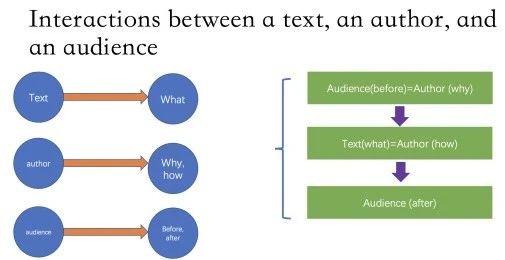 首先介绍下自己,我是一个神奇的三线普高党,首考SAT写作7/7/8。今天我把自己的笔记整合成了这四页Word文档,集齐了SAT最深最好用的套路。
首先介绍下自己,我是一个神奇的三线普高党,首考SAT写作7/7/8。今天我把自己的笔记整合成了这四页Word文档,集齐了SAT最深最好用的套路。
佛脚使用指南
本佛脚笔记是先罗列了一下大致的写作流程,包括文章总体布局和body段的写作模式。后面基于不同的写作手法罗列出了有关手法的分析、标志、常用的词汇以及模板句型等。如果能够熟练掌握并应用佛脚笔记中的所有内容,拿到满意的分数也是大有希望的(笑).body段的展开
以下的内容是通过四个步骤,recognition, information, contribution, effect来布局主体段的内容。1、Recognition
在首段开门见山地提出本段的主题,也就是说,作者具体使用了什么手法。模板句的例子: The author starts his/her article of by recounting a story… The author’s argument is also featured by his use of… Finally, the author makes use of…2. Information
把原文中的主要信息融入到写作中,对于原文进行一定程度上的引用或改写,是抽象化、概括化的过程。注意筛选信息,不是所有内容都需要写进去,只需要寻找最重要最值得分析的部分。3. Contribution
作者是如何支持了他自己的观点,主体是作者。4. Effect
使读者想到的,感受到的内容,主体是读者。Notice
1. coherence, 一个策略穿到底; 2. 后两个部分的每一句话, author, reader, strategy; 3. 在分析中主要提及author’s purpose, enable readers to think…about the claim, enable readers to feel…; 4. 段落总结句再次提及readers和效果(套话)。文章布局
开头段
文章的标题、作者的全名、中心论点、下面要分析的三种手法: Notice: 1.主旨不能中立,只能有一个立场 2.如果对于中心论点不确定,可以看文章最后的方框中的内容 3.文章的标题注意要用双引号来引用 Model: 1.In response to…, the author…argues that… 2.In the article, “…”by “…”, …makes an argument claiming that 3.…builds an argument to persuade his/her audience about…结尾段
为省时间可直接重复开头的内容,但不建议完全不写。主体段
Anecdote Vocabulary: imaginary, vivid, consonance(共鸣), emotion, credible, describe, depict, evoke, inspire, arouse Effect(可以从以下角度思考) 1)场景感和画面感 2)共鸣 3)情感影响 (sense of…可具体) 4)可行度和说服力 Sample Sentence: 1)In telling this brief anecdote, the author… 2)By drawing his/her readers with a personal encounter about…, the author… Example Feature: whole-part, for example; Analysis: explain the “detailed” and “specific” feature Correct part with the whole; Vocabulary: specific, characteristic, typical, representative, clarify, detailed, concrete, clear, illustrate, demonstrate, clarify, show, indicate, explain, illuminate; Effect(可以从以下角度思考) 1)清晰明确 explicit, define, definite 2)信服度 credible, reliable 3)具体,细节 detailed, concrete, typical 4)部分连接到整体 easily connect to the claim, build a link between the author and audience 5)逻辑 logos Statistics Feature: number, numerals; Analysis:explain the feature of the data 找趋势性、极端数据; Vocabulary: precise, factual, credible, scientific, believable, undeniable, present a series numbers, explain, show, validate, justify, solidify, emphasize, imply; Effect (可以从以下角度思考) 1)准确度 accuracy, precision, exactness 2)直观清晰 direct, definite, obvious, explicit, clear 3)数据内涵 trend, considerable size 4)可信度 credibility, reliable, power 5)无可辩驳 irrefutable, undeniable 6)逻辑 logical Notice: 一个主体段不要写太多数据,数据本身不能用作pathos Fact Feature: poll, survey, research; Vocabulary: irrefutable, cold, hard, authentic, credible; Effect: build a reliable case, logos; Contrast Analysis: the implementation of the contrast targets, point out the “emphasis” effect(一定要总结出对比双方); Feature: distinct difference, antonym; Vocabulary: dramatize, sharp, converse, opposite, different, distinct, highlight, impression; Effect: pathos, logos; Comparison Analysis: the implication of the target, point out the “clarify” and “emphasis” effect; Feature: similarity, dissimilarity; Vocabulary: different, impression, clear, logically, reasonable, weigh the advantage and disadvantage in a rational way; Effect: logos; Rebuttal Analysis 1)find out counterargument 2)explain how does the author refute the counterargument (method/evidence) 3)how and what does readers change their mind after the rebuttal 4)effect Vocabulary: challenge the tradition/common sense, significant, undeniable, eliminate doubt, surprise readers, indefensible Model 1)To acknowledge the counterargument raised here, the author refutes the claim that… 2)The author recognizes counterargument against his/her argument, he/she uses powerful evidences to make a rebuttal that… 3.)The author mentions…to acknowledge the counterargument that…, and refutes the claim by stating… Diction / Word Choices Analysis: suggest how the author want us to view the subject, explain the connotation and tone, look for similarities between words; Feature: stance, tone, and bias; Vocabulary: specific, positive/negative, mood; Effect: appeal to pathos; Notice: 解释connotation (the meaning or feeling of a word),把diction分组写,同组为同语气,一段写2-3组。 Rhetorical Question Analysis: find out the implication, focus on the “elicit emotion or thinking” part; Feature: asked merely for effect with no answer expected; Vocabulary: emphasis, provocation, stirring one’s feeling, tug at one’s heart string, heartfelt ponderance, inquiry, encourage, force.; Effect: pathos, add emphasis, elicit emotion and thinking, draw attention Parallelism Analysis: quote the repeating or theme, find out the author’s purpose, highlight/call to attention/summon/criticize; Feature: same syntax or sentence structure; Vocabulary: emphatic, powerful, repetitive, echo, strengthen; Effect: pathos (appeal to emotion), strengthen the claim, clarity, memorable, rhythm of the language, sense of urgency; Simile / Metaphor Analysis: explain the connotation of the喻体, connect the喻体和本体; Vocabulary: figurative, characterize, similarity, compare…to…, connotation, dramatize, imagery; Effect: create imagery, make the claim vividly, establish connection between…and…; Allusion Analysis: explain the historic event, literature…; explain the connection between two things; Feature: use common knowledge to explain unfamiliar things; Vocabulary: allude, reference, similarity, familiar; Effect: pathos, association, familiarity, add significance to the idea, clarity, appeal to history. 以上就是在SAT写作中的文章布局和常用写作手法的语料(套路),如果大家能够掌握了这些内容,并结合具体的考试文章将这些套路融合到写作中去,相信取得一个较为不错的成绩并不是一件难事。当然,临近考试抱一抱佛脚,平常的练习也不能够不重视。祝大家在十月份都能够拿到满意的成绩,成功分手SAT!历年SAT精校版真题+答案
欢迎扫码添加TD客服微信
并发送关键字「SAT真题」领取












